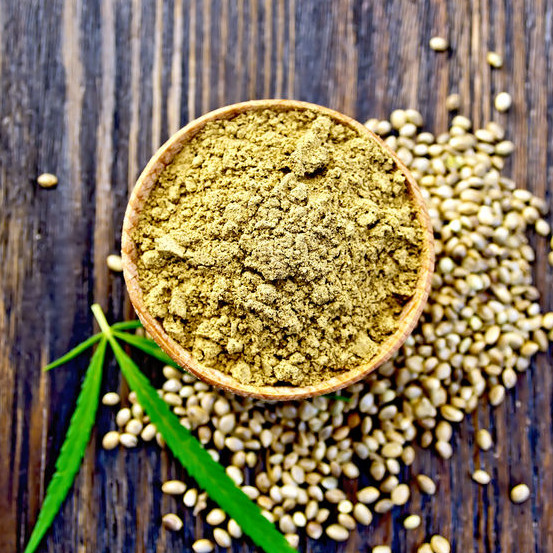
Hemp
Also known as hemp achene
What is Hemp?
Hemp is a tiny oilseed with a characteristic nutty flavor. It belongs to the Cannabis family but contains only trace amounts of the psychoactive compound Tetrahydrocannabinol (THC) (<0.3%). It can be used in crackers, breads, cookies and cakes and its oil is considered a delicacy butter replacement.1
The following forms of hemp seed are available commercially:
- Whole
- Defatted
- Oil
- Milk
- Flour
Origin
Hemp (Cannabis sativa L) is considered an ancient crop which was originally cultivated in China over 4500 years ago. Its usage declined throughout the years but was revived in the late 20th Century. Interest in the dehulled seeds surged in the 1990s and its applications expanded to include nutritional and nutraceutical preparations as well as foods and beverages.1
Function4
The seeds can affect critical properties of baked goods by providing:
- Flavor and taste: unique nutty flavor
- Texture: reduced crumb flexibility and consistency
- Aroma: strong characteristic aroma due to the presence of alpha-humulene, caryophyllene and caryophyllene oxide
- Color: light brown crumb color
Nutrition
Hemp seeds are an excellent source of proteins (20-25%), carbohydrates (20-30%), oil (25-35%), dietary insoluble fiber (10-15%) and minerals. The protein in the seeds is rich in essential amino acids and its oil contains high levels of polyunsaturated fatty acids (omega-3 and omega-6) in optimum ratio.2
Commercial production4
As a by product of hemp fiber manufacture, seeds, oil and flour can be produced via the following processes:
- Cleaning: grain separation from contaminants by sieving and air blowing through several screens
- Cold-pressing: the seeds are crushed using a screw or press to remove the oil
- Grinding: the cake is ground to reduce particle size
- Separation: powder is separated by several sieves to recover the fine flour
Application
In addition to improving the nutritional value, hemp seed and its derivatives—flour, oil and protein—can improve the functional performance of baked goods.
Bread prepared with 5-10% hemp substitution of wheat flour can raise bread volume, improve crumb structure and increase bread shelf life. One challenge remains with bread is the potential development of a brownish-green color and strong aroma.3
Sugar cookies made with 100% hemp flour showed a significant decrease in taste and other sensory properties as well as altered texture mainly chewiness and doneness. Gluten-free cookies made with 20% hemp flour and 80% corn flour tends to increase the water absorption capacity and sensory acceptance.5
Bread prepared with 1% hemp seed oil had higher dough and bread volume with minimum impact on the bread color despite the oil’s characteristic green color. Crumb appearance was relatively unchanged.3
FDA regulations
De-hulled hemp seeds, hemp seed oil and hemp seed protein are recognized as GRAS by the food and drug administration since 2018.6
References
- Crescente, Giuseppina et al. “Chemical Composition And Nutraceutical Properties Of Hempseed: An Ancient Food With Actual Functional Value”. Phytochemistry Reviews, vol 17, no. 4, 2018, pp. 733-749. Springer Science And Business Media LLC, doi:10.1007/s11101-018-9556-2.
- Taheri-Garavand, A. et al. “Physical And Mechanical Properties Of Hemp Seed”. International Agrophysics, vol 26, no. 2, 2012, pp. 211-215. Institute Of Agrophysics Polish Academy Of Sciences, doi:10.2478/v10247-012-0031-9.
- Mullerova, M et al .”Use Of Hemp Raw Materials In Common Bakery Product Recipes”. MendelNet 2016, Brno, Czech Republic 09-10 November,MendelNet 2016, 09 November 2016,
- Pojić, Milica et al. “Bread Supplementation With Hemp Seed Cake: A By-Product Of Hemp Oil Processing”. Journal Of Food Quality, vol 38, no. 6, 2015, pp. 431-440. Wiley, doi:10.1111/jfq.12159.
- Lukin, A & Bitiutskikh, K. “Investigation on the use of hemp flour in cookie production”. Bulgarian Journal of Agricultural Science. vol 23, no 4, 2017, pp. 664-667.
- Food and Drug Administration (FDA). “GRAS Notices”. Accessdata.Fda.Gov, 2018, https://www.accessdata.fda.gov/scripts/fdcc/?set=GRASNotices&sort=GRN_No&order=DESC&startrow=1&type=basic&search=hemp . Accessed 25 Apr 2020.

